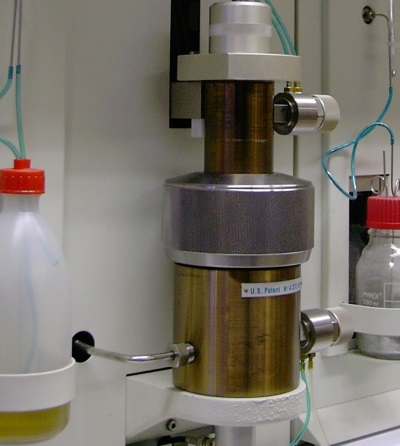Mercury porosimetry uses the non-wetting properties of mercury to gain information on the porous characteristics of solid materials: porosity, pore volume, pore size distribution and apparent density. During a typical porosity analysis in a mercury porosimetry analyzer, the sample under investigation is fully submersed in mercury and exposed to a pressure cycle. Due to the non-wetting properties of mercury, a higher pressure is needed to force intrusion of mercury in smaller pores, whereas mercury intrusion in larger pores already occurs at low pressure. Since a wide range of pressures are applied starting from vacuum up to a maximum pressure of 400 MPa, also a wide dynamic range of pore sizes can be measured. The Washburn equation is used to transform the applied pressure into a pore diameter. In this Washburn equation also the surface tension of mercury and the contact angle are used. In this way, mercury porosimetry can measure pore sizes from 4 nanometer (400 MPa) up to approx. 800 micrometers (vacuum). As a consequence, mercury porosimetry is extremely suitable for materials showing broad distributions of pore sizes or mainly macropores such as granules, extrudates, or large particle size materials. Delft Solids Solutions also provides the option to investigate the contact angle of mercury with the sample under investigation as this influences the pore size calculations and provides more accurate analysis results.
Prior to the mercury porosimetry analysis, vacuum or flow degassing is used to remove moisture from the porous structure. Besides information on porosity obtained by pores located in the interior of the solid (intra-particle porosity), also information on the void space between particles (inter-particle porosity) can be derived. This type of data can be used to determine different types of density: bulk density, apparent density and eventually true density if all the available porosity can be adequately accessed during the mercury porosimetry experiment. Specific surface area information can also be derived from the mercury porosimetry measurement, but this information is much more reliable obtained from physical gas adsorption measurements using the BET analysis.
The low and high-pressure mercury intrusion porosimetry measurements can be executed on different types of mercury porosimeters. Porosity measurements are performed on the CE Instruments Pascal 140 and 440 porosity analyzer or a Micromeritics Autopore IV 9505 porosimeter. The typical result of a mercury porosimetry measurement comprises a graphical representation of the mercury intrusion curve and extrusion curve and the corresponding pore size distribution accompanied by data on pore volume, pore size, density and porosity. Especially careful analysis of the shape of the intrusion and extrusion curves can provide additional information on pore network effects, which is useful in overall mercury porosimetry studies.




